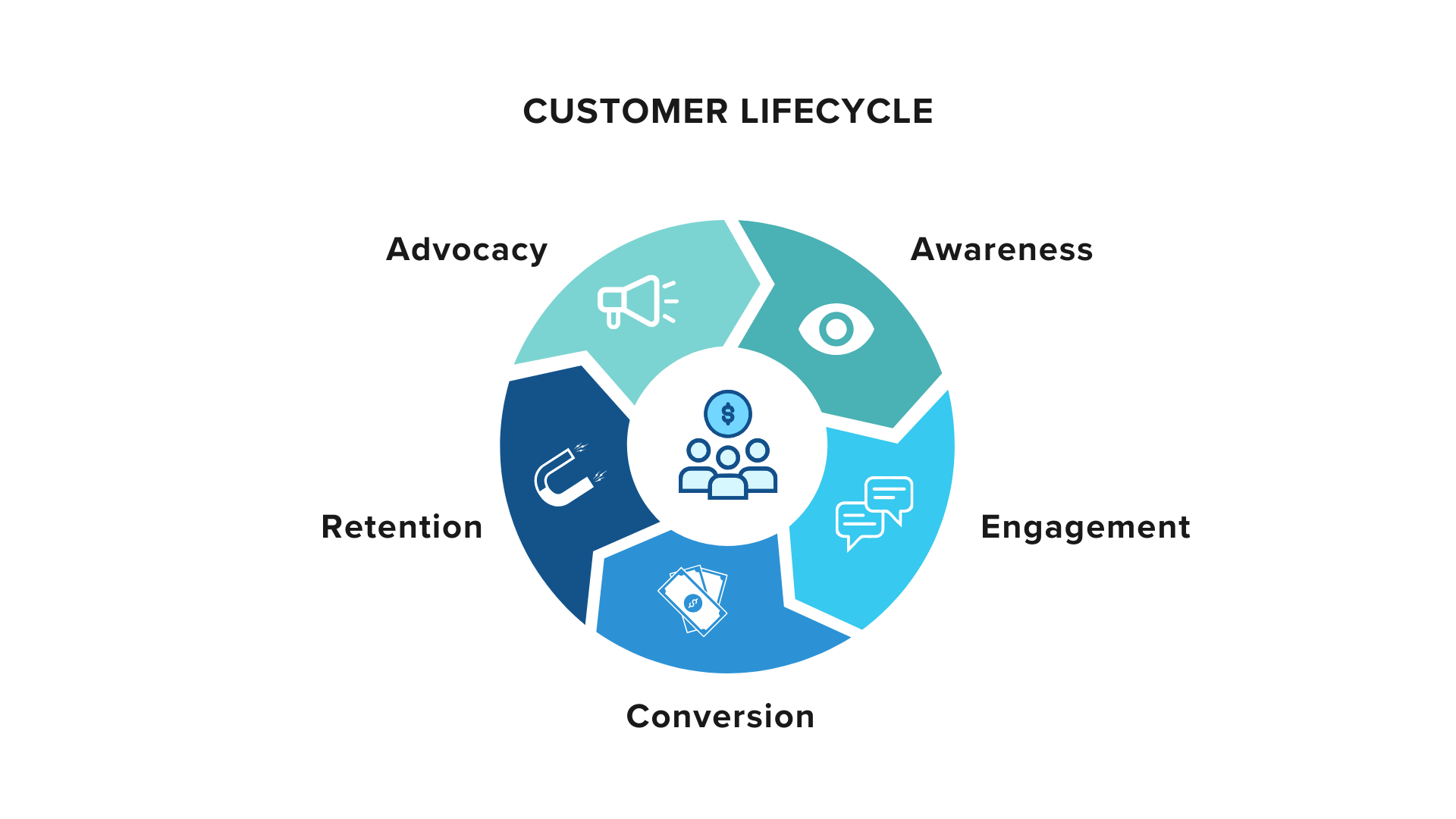Winning a customer is just the opening act; the real show lies in keeping them loyal and engaged.
Customer loyalty is a result of multiple milestones that a brand accomplishes across different stages of the user journey.
Excelling at Customer Lifecycle Management (CLM) is central to this mission.
Explore this guide, where we unravel CLM, spotlight its distinction from mere sales pathways and hand you the strategies to transform fleeting customers into lifelong brand champions.
What is customer lifecycle management?
Customer lifecycle management is the strategic practice of tracking and optimizing each phase of the customer journey, from awareness to purchase and beyond. By regularly evaluating each stage, businesses can adapt sales, marketing and support strategies, ensuring they work together to consistently meet evolving customer needs and drive customer loyalty.
It leverages customer data insights from different journey stages to tailor personalized interactions and nurture sustained brand engagement. Plus, it helps gauge crucial metrics like customer lifetime value (CLV). It usually spans five stages: awareness, engagement, purchase, retention and advocacy.
Suggested read: How to create a customer journey map
The sales funnel is a part of customer lifecycle management
CLM and sales funnels both address the customer's journey. However, essentially speaking, the sales funnel is a subset within CLM — focusing solely on acquisition.

While the sales funnel visually maps a customer's progression from prospect to purchase, emphasizing lead conversion, CLM delves deeper, capturing the entire relationship from initial interest through post-purchase experiences.
Let me put this into perspective a little more imaginatively.
Say you're guiding a visitor through your business.
A sales funnel showcases the path from their first curious step to the point they decide to buy. It's focused on clinching that deal.
In contrast, client lifecycle management is like the attentive host ensuring their entire stay, from arrival to fond farewells, is memorable.
So, while sales funnels get them in the door, CLM ensures they keep coming back.
Importance of customer lifecycle management
Customer Lifecycle Management (CLM) is like a roadmap to long-term business success. Think of your customers as friends. As you wouldn't forget about a buddy after one chat, businesses shouldn't dismiss customers after a single sale. It means taking care of your customers from hello to goodbye and everything in between. In fact, with strategic management of the customer lifecycle, there are no goodbyes at all.
CLM helps businesses win repeat sales and referrals. With well-oiled customer journeys, businesses are able to
Identify challenges early: Just as you'd want to know if a friend is struggling, businesses can spot issues their customers face and intervene before they escalate.
Provide timely support: Whether it's a query about a product or a hiccup in service, being there to assist reinforces trust.
Nurture loyalty: By consistently showing customers they matter, businesses foster a lasting bond that's impervious to market fluctuations or competition.
Drive repeat business: A happy customer doesn’t just return; they bring friends along.
For instance, imagine a customer buying a software subscription from a tech company. Through CLM, this company notices the customer hasn’t activated their account after a week.
Instead of waiting, the company proactively reaches out with an easy setup guide, turning an inactive subscriber into an engaged user. Without CLM, the re-engagement opportunity would slip by, pushing the at-risk customer closer to churn. This kind of attention to detail showcases the true value of understanding and catering to the entire customer journey.
CLM vs. CRM
Customer relationship management (CRM) is a system for managing a company’s interactions with current and potential customers. Both CRM and CLM prioritize building and maintaining strong customer relationships and utilize data analytics for strategic decision-making.
But they aren’t really the same. Here are the precise differences between customer relationship management and customer lifecycle management.
Aspect | CLM | CRM |
Goal | Map out and improve every stage of the customer journey | Centralize customer data and sales leads, and streamline interactions |
Primary focus | Navigating the customer through every stage from first contact to eventual exit | Focused exchanges mainly within sales, service and marketing contexts |
Scope | Holistic oversight; acquisition, purchase, retention, loyalty | Specific strategies to manage sales processes, customer service and marketing outreach |
Tools often used | Journey mapping tools, feedback systems, churn prediction analytics and engagement monitoring | Contact databases, sales tracking, ticketing systems |
Data type | Customer journey data, milestones, touchpoints and overall customer experience metrics | Contact details, purchase history, interactions, communications and service requests |
Strategic outcome | Long-term customer loyalty and business growth | Improved sales, efficient data management, enhanced service |
What is a customer lifecycle map?

A customer lifecycle map is a visual representation and strategic framework that tracks the different stages a customer goes through during their relationship with a brand or product.
Technically, it charts touchpoints, interactions and decisions made by customers. By detailing every stage, it provides insights into engagement, pain points and opportunities.
Essentially, it's a strategic tool, that helps businesses optimize interactions, enhance experience and identify areas for improvement. Imagine having a clear blueprint for every step your customer takes with your brand.
5 stages of the customer lifecycle in organizations
Your customer's lifecycle isn't a straightforward journey from point A to B. Instead, it's filled with various touchpoints, interactions, and moments that unpredictably influence their perception and loyalty.
To elevate these moments, you need to understand and enhance each stage a customer goes through with your brand. Here are five stages of a typical customer lifecycle.
1. Awareness
At this foundational stage, customers first encounter your brand or offering. Perhaps serendipitously, or through a friend's casual mention. The digital world is vast, and whether they found you while wandering the alleys of search engines or got directed by a well-meaning peer, the first impression counts. It’s the first handshake!
Craft a solid content plan that includes blogs, infographics, and webinars to cater to diverse audience tastes
Use ad campaigns that underscore your unique value propositions
Dive into your brand community or industry-specific groups to stamp your thought leadership
To see how the customer lifecycle works, let’s tag along with Emily in her search for the perfect headphones.
Emily’s favorite headphones just gave out mid-jog. Major bummer.
Later, while drowning her sorrows in a Spotify binge, she spots an ad for a brand touting a "game-changer in sound quality".
That same day, her best friend mentions the same brand in a text, “Girl, these headphones changed my life. 🎧❤️ You HAVE to check them out!”
2. Engagement
It's one thing to capture attention, and another to sustain it. Engagement is the stage where you need to keep a prospective customer invested and curious.
Here, the initial intrigue turns into active research and exploration. They've taken a second look and want to know more about what you offer. It's crucial to keep them intrigued and nourished with value.
Offer playful content like quizzes or polls to engage and gather insights
Hand out free trials or samples, giving a little taste of what's on the full plate
Rally virtual Q&A sessions or webinars where you can chat and clear up any looming queries
Curiosity piqued, Emily jumps onto their website where a chatbot pops up asking, "Lost in the world of headphones? Take our quick quiz!"
Intrigued, she dives in.
Answering fun questions about her lifestyle, music preferences and even color choices, the quiz concludes with a personalized headphone recommendation just for her.
3. Conversion
The crucial juncture of commitment. It is the delightful moment when a casual browser decides, "Yes, this is it." This is the phase where interest translates into a tangible transaction.
But even at this peak, a little doubt can deter them. Here, the line between contemplation and purchase is thin.
Streamline the checkout with clear CTAs, varied payment options, and a smooth journey
Be upfront about pricing and keep return and refund policies within easy reach
Allow customers a direct line of communication with live agents [RM41]
Equip agents with a unified customer profile view to tailor interactions, speeding up conversions
Emily is moments from closing the tab, but wait! An email arrives: "Hey Emily, 15% off on your first purchase, because you’re special."
Shortly after, another grabs her attention, “48-hour flash sale alert!”
The deal's too sweet; Emily confidently clicks “Buy Now”.
4. Retention
Having acquired a customer, the journey doesn't end. It morphs into ensuring they continue to derive value, turning a one-time purchase into a recurring pattern.
Imagine you've had a great date. You'd want another, right?
Similarly, after the initial purchase, the challenge is keeping the charm alive. They shouldn’t just remember you; they should eagerly await round two.
Establish feedback loops; maybe a casual chat or customer survey to know how things are going.
Dispatch post-purchase emails with tutorials or fun user guides to accentuate product value.
Introduce customer self-service, so they can find answers even when you're not around.
Roll out a loyalty program. A point here, a discount there — it all adds up!
A couple of days later, a neatly packed box arrives. Inside, along with her shiny new headphones, there’s a handwritten note: "For the love of beats, enjoy, Emily!"
A week later, a friendly email drops some cool care tips and teases an exclusive music event. "Members-only? Fancy!", she thinks.
5. Advocacy
A satisfied customer is a brand's best ambassador. At this stage, customers don't just use your product; they vouch for it, influencing others in their circle.
Use a tool to manage your reviews to spotlight top feedback on the website or social platforms.
Launch a referral program, rewarding customers for bringing in new leads.
Run campaigns to encourage user-generated content (UGC), where customers share unique ways they use the product or service.
Read more: How to leverage UGC to drive engagement & conversions on social media
Fast forward, and Emily gets a sneak peek at their swanky new accessory line. They send her a unique referral link: "Get your pals on board, and we'll treat ya!"
Now, she's all about this brand and can't help but spread the word.
Rounding it up, Emily's headphone journey was more than a purchase, it was an immersive brand experience that nurtured her from discovery to advocacy. It’s stories like these that highlight the immense potential of fine-tuned customer lifecycle management.
Let's pivot and unravel the steps to craft a compelling CLM strategy.
5 steps to create a customer lifecycle management strategy
Nailing the entire customer lifecycle is where the real gold is. Think about it: hotel guests are 61% more likely to rave about their stay and health insurance users are 73% happier when the whole journey shines, not just random touchpoints. That’s why you need to plan your customer lifecycle management strategy.
1. Define your ideal customer profile
Empathize with your customer and craft robust profiles that capture more than mere demographics. Delve deep into psychographics, buying behaviors, pain points and their expectations from your product. Recognize not just who they are, but why they might choose you. This forms the basis for future targeting and personalization.

2. Build a customer experience framework
Focus on creating a CX framework that helps you provide bespoke experiences. Tailor offers, content and communication based on their previous interactions, buying behavior and preferences. Here’s a quick run-through of how to do it:
Aspirational vision mapping: Begin with a clear, quantifiable vision that mirrors organizational goals. Think of it as plotting a road trip with clear, measurable pit stops along the way.
Data-driven micro-segmentation: Instead of just scratching the surface with broad data insights, zone in on those niche customer needs.
Governance & ownership: Ever played a game without rules? Chaos, right? Clearly define who oversees what in your CX initiatives. Have protocols in place for regular strategy evaluations and realignments.
Tech integration & anti-siloing: Prioritize technologies that not only collect data but ensure its seamless flow across platforms. Eliminate data silos that stymie effective decision-making.
Get to the bedrock: Your go-to guide to create a solid customer experience framework
3. Simplify channel hopping
Delivering omnichannel customer experiences isn’t a luxury anymore, but a necessity. So, you need to go beyond just having multiple touchpoints. Make the transition between these touchpoints seamless:
State-persistent interactions: If a customer starts a process on one channel, aim to complete the transaction on the same channel. If the customer must move to another, their progress and data should carry over without them having to start over.
Predictive channel engagement: Use analytics to predict, prepare and assign your agents to the most likely next channel a customer will engage with.
4. Rethink the purchase process
Shopping has changed. Your customers expect you to not only know what they want but also predict their next move. Here's how to up your game and redesign the buying journey:
Anticipatory design: Predict what customers are likely to want next and present options tailored to those predictions.
Friction diagnostics: Use technology to pinpoint where customers experience friction in the purchase process and streamline those points.
Dynamic pricing models: Implement pricing models that adjust in real-time based on demand, customer behavior, or other variables.
For example, using live-chat support at checkout can especially be useful. Customers who are just about to convert, but are facing a transactional issue would want nothing more than a live agent’s help at the moment.
5. Embrace proactive and self-service
The modern consumer values independence. They appreciate having the tools at their disposal to solve issues or gain insights without always reaching out for help. Consider:
Data repository & FAQs: Develop a detailed, user-friendly knowledge base where customers can easily find solutions to common queries.
Predictive assistance: Leverage AI and data analytics to identify potential issues a user might encounter, offering proactive customer service
Chatbots & virtual Assistants: Conversational AI bots can handle, both, answering basic questions to guiding users through complex procedures, ensuring 24/7 assistance.
Learn more: Tips for creating a proactive customer service strategy

Best practices in customer lifecycle management
The customer journey for every business looks different. Here are the best practices in customer lifecycle management.
Reinforce value prop: Regularly remind customers of the unique benefits of your product or service, ensuring they always see the value.
Tailor content to lifecycle stage: Create content tailored to each lifecycle stage, ensuring you’re addressing the right concerns at the right time.
Run retargeting campaigns: Use retargeting ads to reel back those who’ve interacted with your brand but haven't converted yet.
Optimize multi-device experience: Ensure your interactions are consistent and optimized across various devices - mobile, desktop, tablet, etc.
Set cadence for communication: Develop a rhythm in your communication, so customers know when to expect updates, newsletters, or any other interactions.
Run drip email campaigns: Automated email sequences can nurture leads at specific intervals or based on actions, ensuring they’re continually engaged.
How businesses use customer lifecycle management: A real-world example
In a world where every customer touchpoint can make or break loyalty, businesses are vying for a perfect score.
But how? Let's delve into a real-life playbook, courtesy of a hospitality giant.
In the throes of a pandemic, Hyatt faced a mounting challenge: ensuring guests remained loyal amidst changing travel behaviors. Their CLM-centric goal was clear - revamp retention and loyalty. Watch how they accomplished this:
Here are the steps Hyatt took.
Omnichannel reach: Adopted a dynamic digital interface to engage guests on their preferred channels, enhancing the guest experience.
Tailored crisis response: Implemented real-time tracking of evolving travel apprehensions, ensuring timely and relevant guest communication.
Deepened personalized engagement: Agents, upon contact, accessed guest histories to deliver bespoke care, making each interaction feel uniquely tailored and valuable.
Hyatt didn't just weather the storm; they thrived. “Our ability to recognize someone in a way that allows us to really care for them in a more personal way helps us drive loyalty,” explains Vander Ploeg, Global Head of Digital and Technology at Hyatt.
With a globally coordinated team, an empowered Hyatt addressed concerns 34% quicker. The result was an unwavering guest trust and a brand that stood resilient amidst challenges.
“When we work with Sprinklr, I wouldn't even say it feels like we're working with an enterprise software company,” Vander continues.
“It's a great group of people and leaders who genuinely want to understand our business, the outcomes we're trying to achieve, and how they can be helpful."
That's elite brand talk, not small talk! Ready to sprinkle some Sprinklr magic? Book a demo now!
Frequently Asked Questions
Customer service in the awareness stage of CLM acts as a beacon. It shines a light on the brand's essence during initial interactions.
Addressing early queries, sharing resources, and guiding prospects to the right solutions shape the brand's image, making sure prospects step out well-informed and feeling valued.
Thank you for contacting us.
A Sprinklr representative will be in touch with you shortly.
Contact us today, and we'll create a customized proposal that addresses your unique business needs.
Request a Demo
Welcome Back,
No need to fill out any forms — you're all set.


